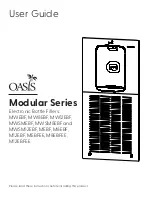
LCC
12
Caution
Suction lift lines should be laid with a rising slope towards
the pump and suction head lines with a downward slope
towards the pump. The pipelines should be anchored in
close proximity to the pump and should be connected
without transmitting any stresses or strains. The nominal
diameters of the pipelines should be at least equal to the
nominal diameters of the pump nozzles. It is
recommended to install check and shut-off elements in the
system, depending on the type of plant and pump. It must
be ensured, however, that the pump can still be drained
and dismantled without problems.
Thermal expansions of the pipelines must be
compensated by appropriate measures so as not to
impose any extra loads on the pump exceeding the
permissible pipeline forces and moments.
An excessive, impermissible increase in the pipeline
forces may cause leaks on the pump where the medium
handled can escape into the atmosphere.
Danger of life when toxic or hot media are
handled.
The flange covers on the pump suction and discharge
nozzles must be removed prior to installation in the piping.
5.4.1 Auxiliary
Connections
The dimensions and locations of the auxiliary connections
(cooling, heating, sealing liquid, flushing liquid, etc.) are
indicated on the installation plan or piping layout.
These connections are required for proper
functioning of the pump and are therefore
of vital importance!
5.4.2
Safety Guards
In compliance with the accident prevention
regulations the pump must not be operated
without coupling and drive guards. If the customer
specifically requests not to include guards in our delivery,
then the operator must supply them.
5.5
Final Check
Re-check the alignment as described in Section 5.3.
It must be easy to rotate the shaft by hand at the coupling.
5.6
Connection to Power Supply
A
trained electrician
must make the connection to the
power supply. Check available mains voltage against the
data on the motor rating plate and select the appropriate
start-up method.
We strongly recommend the use of a motor protection
device.
6 Commissioning,
Start-up
/
Shutdown
Compliance with the following
requirements is of paramount importance.
Damage resulting from non-compliance
shall not be covered by the scope of warranty.
This manual applies to single stage pumps. Procedures
for multistage pumps should be obtained from GIW/KSB
sales office.
6.1 Commissioning
Before starting up the pump make sure that the following
requirements are checked and fulfilled.
The operating data, the oil level, if required (6.1.1), the
nose clearance, and the direction of rotation (6.1.4) must
be checked. The pump set must be primed (6.1.3).
x
Make sure the unit is properly connected to the
electric power supply and is equipped with all
protection devices.
x
Make sure all auxiliary connections (5.4.1) are
connected and functioning.
x
If the pump has been out of service for a long period
of time, proceed in accordance with Section 6.4.
6.1.1 Lubricants
Grease Lubricated Bearings
Grease lubricated bearings are packed with grease at the
factory. They should be re-lubricated after the initial 50
hours of operation, and at regular intervals thereafter. See
Section 7.2.2.2 for grease lubrication instructions.
If shaft speeds exceed those in the table below, the
bearing housing temperature should be monitored during
commissioning and additional grease added if it exceeds
100
o
C (210
o
F), or if bearings are noisy . In some cases
where external cooling of the housing is poor, it may be
necessary to stop and allow the bearings to cool several
times during this break-in period.
Some lubricant may be expelled from the labyrinth oil
seals upon startup. This is normal and will stop once the
excess grease has been purged.
Oil-lubricated bearings
Units may be shipped without oil from the factory. Fill with
the supplied GIW Blue 150 oil to the center of the sight
gauge.
Before starting the pump, verify that the bearing assembly
is correctly filled to the center of the oil level sight gauge
.
Do not overfill
. Factory filled units contain GIW Blue ISO
150 synthetic bearing oil. This is available as GIW part
number 690-9090P-01-B150P. Otherwise, use an
equivalent synthetic or a high quality ISO220 mineral oil
suitable for use with heavy industrial equipment, anti-
friction bearings and oil circulating systems. Such oil
typically have high temperature stability, resistance to
oxidation and foaming, and inhibit rust, corrosion, and the
formation of deposits. Oils with EP additives are not
recommended.
Typical oil operating temperatures for GIW bearing
assemblies will run from 125 to 185°F (50 to 85°C),
depending on the pump size, speed and ambient
conditions. For oil temperatures above 185°F (85°C) or
for severe load conditions, a high quality synthetic
Bearing
Assembly
Shaft Speed (rpm), monitor
commissioning temperature if over:
35mm 2300
50mm 1800
70mm 1400
100mm 1000
125mm 750
Caution
Summary of Contents for GIW LCC 100-400
Page 27: ...LCC 27 NOTES ...
Page 34: ......













































